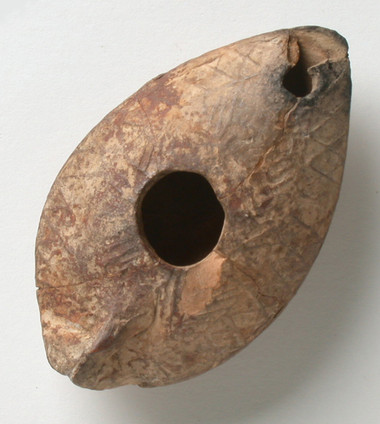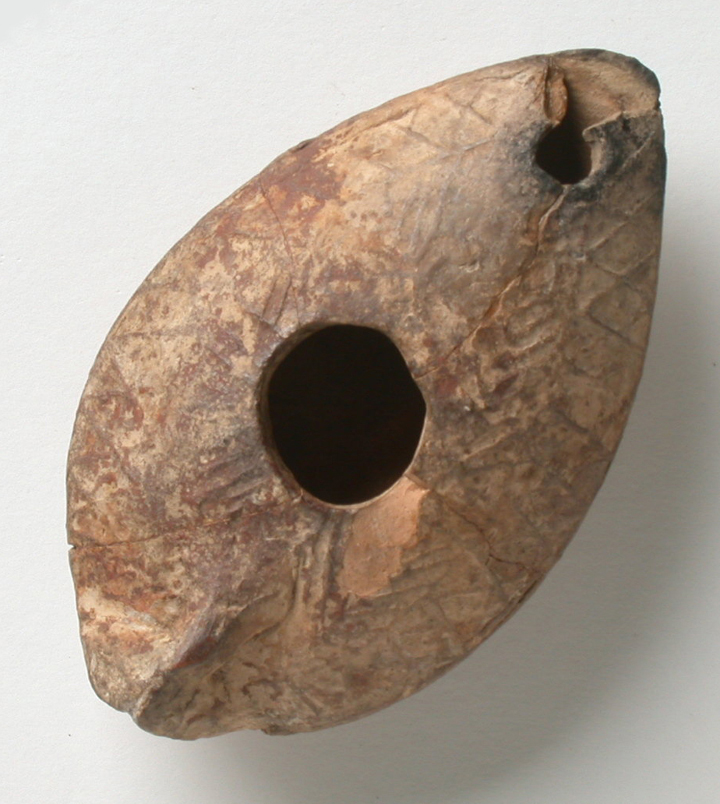Oil Lamp, Ancient Rome, Original
This little lamp can be carried around the house in the palm of the hand. A small lamp like this would have been used with many others to give light to a Roman home.
The main fuel in Western nations was olive oil. In ancient Mediterranean cultures, though extracts from fish, crude fish oil, nuts, and cheese were also used. The oval dish would hold the oil and be covered by a sealed decorated lid called the discus. This discus stops the fuel from spilling. A wick coils inside the lamp and comes out of the spout. This wick could be made of anything fibrous, such as linen. To make light, the wick - like in a candle - is lit. As it burns, it has to be pulled forward to keep it from falling back into the oil.
The lamp was made in two parts, both moulded in clay. The holes for the wick and the filling hole were cut, and the clay then fired in a kiln.
The main fuel in Western nations was olive oil. In ancient Mediterranean cultures, though extracts from fish, crude fish oil, nuts, and cheese were also used. The oval dish would hold the oil and be covered by a sealed decorated lid called the discus. This discus stops the fuel from spilling. A wick coils inside the lamp and comes out of the spout. This wick could be made of anything fibrous, such as linen. To make light, the wick - like in a candle - is lit. As it burns, it has to be pulled forward to keep it from falling back into the oil.
The lamp was made in two parts, both moulded in clay. The holes for the wick and the filling hole were cut, and the clay then fired in a kiln.

Length:11cm
Olive trees flourished (and still flourish) in the hot Mediterranean climate, and the Romans used the oil for many things, including fuel. Today, we too use olive oil but usually only in cooking. The olive tree is one of the oldest cultivated trees in the world. The first olive trees were grown in Asia, spreading to Iran, Syria and Palestine. The Roman used the fruit and the oil and, as their Empire grew, they introduced the olive as fuel and food wherever possible. As olive trees do not grow in Britain, the Romans would have imported the olive oil.
Olive oil was common, but expensive. A teaspoon of oil inside a lamp like this one would last about two hours. Most families could not afford the oil to light their homes for long periods of time at night. Therefore they tended to go to bed when it was dark and to get up when it was day light.
To get oil from the olive, the fruit has to be picked, gathered and cleaned, the stones removed, and the fruit (or pate) pressed and squeezed. The resulting liquid is allowed to settle, and because oil and water do not mix, the oil eventually floats on top of the water, and is removed.
The decorated discus of Roman oil lamps often showed gods, goddesses or gladiatorial scenes. Gods and goddesses - superhuman beings - were worshipped, and different gods and goddesses influenced different aspects of life. For example, Minerva was the goddess of wisdom; Mars the god of war; Venus the goddess of Beauty. Gladiators were men especially trained to fight. They were former slaves, reformed criminals, or prisoners of war. Fights were held as entertainment in amphitheatres on public holidays - a gory spectator sport for the Romans. The gladiators had to fight not just each other but also lions, tigers and bears.
Olive oil was common, but expensive. A teaspoon of oil inside a lamp like this one would last about two hours. Most families could not afford the oil to light their homes for long periods of time at night. Therefore they tended to go to bed when it was dark and to get up when it was day light.
To get oil from the olive, the fruit has to be picked, gathered and cleaned, the stones removed, and the fruit (or pate) pressed and squeezed. The resulting liquid is allowed to settle, and because oil and water do not mix, the oil eventually floats on top of the water, and is removed.
The decorated discus of Roman oil lamps often showed gods, goddesses or gladiatorial scenes. Gods and goddesses - superhuman beings - were worshipped, and different gods and goddesses influenced different aspects of life. For example, Minerva was the goddess of wisdom; Mars the god of war; Venus the goddess of Beauty. Gladiators were men especially trained to fight. They were former slaves, reformed criminals, or prisoners of war. Fights were held as entertainment in amphitheatres on public holidays - a gory spectator sport for the Romans. The gladiators had to fight not just each other but also lions, tigers and bears.

Length:11cm

This little lamp can be carried around the house in the palm of the hand. A small lamp like this would have been used with many others to give light to a Roman home.
The main fuel in Western nations was olive oil. In ancient Mediterranean cultures, though extracts from fish, crude fish oil, nuts, and cheese were also used. The oval dish would hold the oil and be covered by a sealed decorated lid called the discus. This discus stops the fuel from spilling. A wick coils inside the lamp and comes out of the spout. This wick could be made of anything fibrous, such as linen. To make light, the wick - like in a candle - is lit. As it burns, it has to be pulled forward to keep it from falling back into the oil.
The lamp was made in two parts, both moulded in clay. The holes for the wick and the filling hole were cut, and the clay then fired in a kiln.
The main fuel in Western nations was olive oil. In ancient Mediterranean cultures, though extracts from fish, crude fish oil, nuts, and cheese were also used. The oval dish would hold the oil and be covered by a sealed decorated lid called the discus. This discus stops the fuel from spilling. A wick coils inside the lamp and comes out of the spout. This wick could be made of anything fibrous, such as linen. To make light, the wick - like in a candle - is lit. As it burns, it has to be pulled forward to keep it from falling back into the oil.
The lamp was made in two parts, both moulded in clay. The holes for the wick and the filling hole were cut, and the clay then fired in a kiln.




















